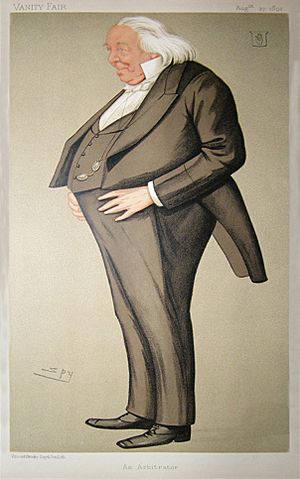Frederick Bramwell facts for kids
Quick facts for kids
Sir Frederick Bramwell, Bt
|
|
|---|---|
 |
|
| Born | 17 March 1818 |
| Died | 30 November 1903 (aged 85) United Kingdom
|
| Occupation | Engineer |
| Engineering career | |
| Discipline | Civil, mechanical |
| Institutions | Institution of Civil Engineers (president), Institution of Mechanical Engineers (president), Royal Society of Arts (president), Royal Society, (fellow) |
Sir Frederick Joseph Bramwell (born March 17, 1818 – died November 30, 1903) was a very important British engineer. He worked as both a civil engineer and a mechanical engineer. A civil engineer designs and builds things like bridges and roads. A mechanical engineer designs and builds machines.
Frederick Bramwell was recognized for his great work. He became a Fellow of the Royal Society in 1873. This is a special group for top scientists. He also led important engineering groups. He was president of the Institution of Civil Engineers from 1884 to 1886. He also led the British Science Association in 1888. He received a special honor, becoming a Knight in 1881. Later, he was made a Baronet in 1889.
Early Career and Contributions
Frederick Bramwell trained to become an engineer. He spent a lot of time studying how steam engines work. In 1843, he built a special train engine. This engine was for the Stockton and Darlington Railway.
Later, in 1853, he started his own business. His company focused on giving expert advice. He also worked on legal cases related to engineering. He was the first engineer to act as a technical expert in court. He also advised the companies that supplied water to London.
Family Life
Frederick Bramwell was the son of George Bramwell. His father was a partner in a bank. Frederick also had an older brother, Sir George William Wilshere Bramwell.
On March 29, 1847, Frederick married Harriet Leonara Frith. She was his cousin. They had three daughters together. One of their daughters, Eldred, married a famous scientist named Sir Victor Horsley.
Frederick Bramwell passed away in London on November 30, 1903. He was buried in Hever, Kent.
Published Work
Frederick Bramwell wrote about his work. One of his notable writings is Our big guns. He wrote this in 1886. It was an address he gave to the Birmingham and Midland Institute. This work came from his time serving on the Ordnance Committee. This committee dealt with large weapons.


